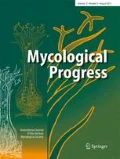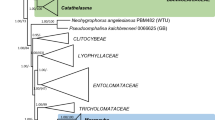Abstract
A new species, Cyptotrama fagiphila, sp. nov., and a noteworthy species recently described from China, Cibaomyces glutinis, are reported from Europe. Their systematic position was confirmed by DNA sequence analyses of the ITS and partial 28S regions of the nuclear rDNA cistron. Based on these data, an emendation of Rhizomarasmius is also proposed to encompass the alpine species Oudemansiella oreina and the marasmioid species Marasmius setosus, and the appropriate combinations Rhizomarasmius oreinus comb. nov. and R. setosus comb. nov. are introduced. The position of Laccariopsis (Oudemansiella) mediterranea is also discussed. Unpublished data on the holotypes of the extra-European species Cyptotrama hygrocyboides, C. platensis, and C. songolarum are provided along with sequence data that indicate C. songolarum belongs in the genus Termitomyces (Lyophyllaceae).






Similar content being viewed by others
References
Antonín V, Noordeloos ME (2010) A monograph of marasmioid and collybioid fungi in Europe. Koeltz, Königstein
Antonín V, Vašutova M, Urban A (2010) A molecularly supported concept of Marasmius epiphyllus (Basidiomycetes, Physalacriaceae). Cryptogam Mycol 31(4):355–362
Binder M, Hibbett DS, Wang D, Farnham WF (2006) Evolutionary relationships of Mycaureola dilseae (Agaricales), a basidiomycete pathogen of a subtidal rhodophyte. Am J Bot 93:547–556
Bodensteiner P, Binder M, Moncalvo J-M, Agerer R, Hibbett DS (2004) Phylogenetic relationships of cyphelloid homobasidiomycetes. Molecular Phylogenetics and Evolution 33:501–515
Boekhout T (1999) Xerula. In: Bas C, Kuyper T, Noordeloos ME, Vellinga EC (eds) Flora agaricina neerlandica, vol 4. Balkema, Amsterdam, pp 181–184
Boekhout T, Bas C (1986) Notulae ad floram agaricinam Neerlandicam - XII: Some notes on the genera Oudemansiella and Xerula. Persoonia 13(1):45–56
Bon M (1999) Collybio–marasmioides et ressemblants. flore mycologique d’ Europe. Doc Mycologiques Mémoire Hors-Série 5:1–171
Breitenbach J, Kränzlin F (1991) Champignons de suisse, tome 3: bolets et champignons à lames, 1ère partie: strobilomycetaceae, boletaceae, paxillaceae, gomphidiaceae, hygrophoraceae, tricholomataceae, polyporaceae. Mycologia, Lucerne, 364 p
Contu M (2000) Il genere Xerula (Basidiomycotina, Agaricales) nell’Italia Centro-Meridionale ed Insulare. Micologia e vegetetazione Mediterranea 15:18–39
Corner EJH (1950) A monograph of Clavaria and allied genera. Ann Bot Memoirs 133:1–740, pl. 1–16
Corner EJH (1970) Supplement to “a monograph of Clavaria and allied genera”. Beihefte zur Nova Hedwigia 33:1–299
Courtecuisse R (1995) Taxonomy of some fungi used by the Songola people (Zaïre). Afr Study Monographs 16(1):45–60
Dörfelt H (1985) Taxonomische studien in der gattung Xerula R. Mre. (X). Feddes Repertorium 96:235–240
Filippi I (1991) Osservazioni ecologiche su Hydropus mediterraneus Pacioni & Lalli. Micol Ital 20(1):43–46
Frøslev TG, Aanen DK, Læssøe T, Rosendahl S (2003) Phylogenetic relationships of Termitomyces and related taxa. Mycol Res 107(11):1277–1286
Gardes M, Bruns TD (1993) ITS primers with enhanced specificity for Basidiomycetes - Application to the identification of mycorrhizae and rusts. Mol Ecol 2:113–118
Guinberteau J, Courtecuisse R (1993) Contribution à la connaissance des Macromycètes psammophiles de la Côte d’Argent (Littoral aquitain) II. Sur quelques taxons rares ou critiques. Bull Trimest Soc Mycol Fr 109(3):123–148
Hao Y-J, Qin J, Yang ZL (2014) Cibaomyces, a new genus of Physalacriaceae from East Asia. Phytotaxa 162(4):198–210
Heim R (1958) Termitomyces. Flore iconographique des Champignons du Congo 7:139–151
Henkel TW, Smith ME, Aime MC (2010) Guyanagaster, a new wood-decaying sequestrate genus of Agaricales from the Guiana Shield. Am J Bot 97(9):1474–1484. doi:10.3732/ajb.1000097
Higgins D, Thompson J, Gibson T, Thompson JD, Higgins G, Gibson TJ (1994) CLUSTAL W: improving the sensitivity of progressive multiple sequence alignment through sequence weighting, position-specific gap penalties and weight matrix choice. Nucleic Acids Res 22:4673–4680
Horak E (1968) Synopsis generum agaricalium. Beiträge zur Kryptogamenflora der Schweiz 13:1–741
Horak E (2005) Röhrlinge und blätterpilze in Europa. Elsevier Spektrum Academischer, Verlag
Jenkinson TS, Perry BA, Schaefer RE, Desjardin DE (2014) Cryptomarasmius gen. nov. established in the Physalacriaceae to accommodate members of Marasmius section Hygrometrici. Mycologia 106(1):86–94. doi:10.3852/11-309
Julich W (1981) Higher taxa of basidiomycetes. Bibliotheca Mycologia 85. Vaduz, Cramer
Kirchmair M, Morandell, S, Stolz, D, Pöder R (2004) Phylogeny of the genus Omphalotus based on nuclear ribosomal DNA-sequences. Mycologia 96(6):1253–1260
Kornup A, Wanscher JH (1978) Methuen handbook of colour, 3rd edn. Methuen, Bristol
Kühner R (1927) Notes mycologiques. Bull Trimest Soc Mycol Fr 43(2):107–116
Kühner R (1933) Études sur le genre Marasmius. Le Botaniste 25(1-6):57–114, pl. V–VII
Kühner R (1980) Les hyménomycètes agaricoïdes (Agaricales, Tricholomatales, Pluteales, Russulales. Étude générale et classification. Bull de la Société linnéenne de Lyon, numéro spécial 49:1–1027
Lebel T, Catcheside PS (2009) The truffle genus Cribbea (Physalacriaceae, Agaricales) in Australia. Aust Syst Bot 22:39–55
Locquin MV (1943) Etude des spores de Mycenella II. Structure de la spore de Mycenella kuehneri Romagnesi. Revue de Mycologie 8:57–61
Ludwig E (1997) Ein neuer sternsporling - hygroaster lacteus und die gattungen hygroaster/omphaliaster aus heutiger sicht. Zeitschrift für Mykologie 63(2):155–162
Manimohan P, Thomas KA (1998) A new species of Gloiocephala from India. Mycotaxon 69:87–91
Mata J-L, Hughes KW, Petersen RH (2007) An investigation of /omphalotaceae (Fungi:Euagarics) with emphasis on the genus Gymnopus. Sydowia 58(2):191–289
Matheny PB, Curtis M, Hofstetter V, Aime MC, Moncalvo J-M, Ge ZW, Yang Z-L, Slot JC, Ammirati JF, Baroni TJ, Bougher NL, Hughes KW, Lodge DJ, Kerrigan RW, Seidl MT, Aanen DK, DeNitis M, Daniele GM, Desjardin DE, Kropp BR, Norvell LL, Parker A, Vellinga EC, Vilgalys R, Hibbett DS (2006) Major clades of agaricales: a multilocus phylogenetic overview. Mycologia 98:982–995
Milne I, Wright F, Rowe G, Marshal DF, Husmeier D, McGuire G (2004) TOPALi: software for automatic identification of recombinant sequences within DNA multiple alignments. Bioinformatics 20(11):1806–1807
Moncalvo JM, Vilgalys R, Redhead SA, Johnson JE, James TY, Aime MC, Hofstetter V, Verduin SJ, Larsson E, Baroni TJ, Thorn G, Jacobsson S, Clémençon H, Miller OK Jr (2002) One hundred and seventeen clades of euagarics. Mol Phylogenet Evol 23:357–400
Moreau P-A (1997) Une récolte d’Hygrophoracée remarquable en Savoie. Bull de la Fédération mycologique Dauphiné-Savoie 144:143–146
Mossebo DC, Amougou A, Atangana RE (2002) Contribution à l’étude du genre Termitomyces (Basidiomycètes) au Cameroun: écologie et systématique. Bull de la Société Mycologique de France 118(3):195–249
O’Donnell K, Cigelnik E, Weber NS, Trappe JM (1997) Phylogenetic relationships among ascomycetous truffles and the true and false morels inferred from 18S and 28S ribosomal DNA sequence analysis. Mycologia 89:48–65
Pacioni G, Lalli G (1985) Entita micologiche del Parco Nazionale del Circeo. XVII. Hydropus mediterraneus sp. nova. Micol Ital 14:5–9
Pacioni G, Lalli G (1989) Novità micologiche dei monti simbruini. Micologia e vegetazione Meditterranea 4(2):29–32
Peck CH (1882) Fungi in wrong genera. Bull Torrey Bot Club 9:1–4
Pegler DN (1983) Agaric flora of the lesser Antilles. Kew Bull Additional Series 9:1–668, pl. 1-26
Pegler DN, Young TWK (1987) Classification of Oudemansiella (Basidiomycota, Tricholomataceae), with special reference to spore structure. Trans Br Mycol Soc 87:583–602
Petersen RH (2000) Rhizomarasmius, gen. nov. (Xerulaceae, Agaricales). Mycotaxon 75:333–342
Petersen RH (2008) Scanning electron microscope image of basidiospores of Xerula (Physalacriaceae, Agaricales). Mycoscience 49:19–34
Petersen RH, Hughes KW (2010) The Xerula-Oudemansiella complex. Nova Hedwigia Beihefte 137:1–625
Qin J, Hao Y-J, Yang ZL, Li Y-C (2013) Paraxerula ellipsospora, a new Asian species of Physalacriaceae. Mycol Prog. doi:10.1007/s11557-013-0946-y
Redhead SA (1987) The Xerulaceae (Basidiomycetes), a family with sarcodimitic tissues. Can J Bot 65:1551–1562
Redhead SA, Ginns J (1980) Cyptotrama asprata (Agaricales) from North America and notes on the five other species of Cyptotrama sect. Xerulina. Can J Bot 58(6):731–740. doi:10.1139/b80-093
Ronikier M, Ronikier A (2011) Rhizomarasmius epidryas (Physalacriaceae): phylogenetic placement of an arctic-alpine fungus with obligate saprobic affinity to Dryas spp. Mycologia 103(5):1124–1132
Ronquist F, Huelsenbeck JP (2003) MrBayes 3: Bayesian phylogenetic inference under mixed models. Bioinformatics 19:1572–1574
Rouland-Lefevre C, Diouf MN, Brauman A, Neyra M (2002) Phylogenetic relationships in Termitomyces (Family Agaricaceae) based on the nucleotide sequence of ITS: a first approach to elucidate the evolutionary history of the symbiosis between fungus-growing termites and their fungi. Mol Phylogenet Evol 22(3):423–429
Singer R (1951) The Agaricales (mushrooms) in modern taxonomy. Lilloa 22:1–832, 1949
Singer R (1960a) New genera of fungi. XI. a marasmioid agaric with bilateral trama. Lilloa 30:375–379
Singer R (1960b) Monographs of south american basidiomycetes, especially those of the east slope of the Andes and brazil. 3. reduced marasmioid genera in south america. Sydowia 14(1–6):258–280, pl. 36–40
Singer R (1964) Oudemansiellinae, macrocystidiinae, pseudohiatulinae in South America. Darwiniana 13(1):145–190
Singer R (1969) Mycoflora australis. Beihefte zur Nova Hedwigia 29:1–405
Singer R (1973) Diagnoses fungorum novorum agaricalium III. Beihefte zur Sydowia 7:1–106
Singer R (1986) Agaricales in modern taxonomy, 4th edn. Koeltz Sci. Books, Germany
Singer R (1989) New taxa and new combinations of Agaricales (Diagnoses fungorum novorum Agaricalium 4). Fieldiana Botany 21:1–133
Tamura K, Dudley J, Nei M, Kumar S (2007) MEGA4: molecular evolutionary genetics analysis (MEGA) software version 4.0. Mol Biol Evol 24:1596–1599
Vizzini A, Ercole E, Voyron S (2012) Laccariopsis, a new genus for Hydropus mediterraneus (Basidiomycota, Agaricales). Mycotaxon 121:393–403
Wilson AW, Desjardin DA (2005) Phylogenetic relationships in the gymnopoid and marasmioid fungi (Basidiomycetes, euagarics clade). Mycologia 97(3):667–679. doi:10.3852/mycologia.97.3.667
Yang Z-L, Zhang L-F, Mueller GM, Kost GW, Rexer K-H (2009) A new systematic arrangement of the genus Oudemansiella s. str. (Physalacriaceae, Agaricales). Mycosystema 28(1):1–13
Acknowledgments
To Véronique Bourgade and Caroline Loup (Service des Collections, herbarium MPU, University Montpellier 2) for her assistance to P.-A. M. in consultation of Maire’s documents and for allowing the reproduction of Maire’s unpublished plate. To Dennis Desjardin (H.D. Thiers Herbarium, San Francisco, CA, USA) for the loan of the holotype of Gloiocephala resinopunctata and for his valuable remarks about Gloiocephala. To Patricia Rogers (MICH) for details concerning the isotype of C. macrobasidiatum and for having supported loan request of this material. To Yan-Jia Hao and Prof. Dr. Zhu L. Yang (Kunming, China) for having leant their sequences of Cibaomyces glutinis before their release in GenBank.
To Régis Courtecuisse (herbarium LIP, Université Lille 2) for the loan of material from M. Bon’s collections (LIP), revision of the manuscript and helpful suggestions, and to Christophe Lécuru for his assistance in tracking material and notes of M. Bon in LIP.
To Mathieu Sauve (Montpellier) for technical assistance in molecular work, Béatrice Boury (DSI, Université Lille 2) for computer assistance, and to Giovanni Consiglio, Pascal Hériveau and Scott A. Redhead for bibliographic supply.
To Gilles Corriol and Carole Hannoire (Conservatoire Botanique national des Pyrénées et de Midi-Pyrénées, Bagnères-de-Bigorre), François Fourot (†), Frieder Gröger (Berlin), Renée Lebeuf and André Paul (Montréal), and Erhart Ludwig (Berlin), for the gift of interesting collections and personal data and observations cited in this paper.
The studies of V. Antonín were realized through financial support provided to the Moravian Museum by the Ministry of Culture of the Czech Republic as a part of its long-term conceptual development program for research institutions (DKRVO, ref. MK 000094862)
This paper is dedicated to the memory of the French mycologist Marcel Bon (1925-2014), author of inspiring works in taxonomy.
Author information
Authors and Affiliations
Corresponding author
Rights and permissions
About this article
Cite this article
Moreau, PA., Vila, J., Aime, M.C. et al. Cibaomyces and Cyptotrama, two new genera for Europe, and an emendation of Rhizomarasmius (Basidiomycota, Physalacriaceae). Mycol Progress 14, 4 (2015). https://doi.org/10.1007/s11557-015-1024-4
Received:
Revised:
Accepted:
Published:
DOI: https://doi.org/10.1007/s11557-015-1024-4




